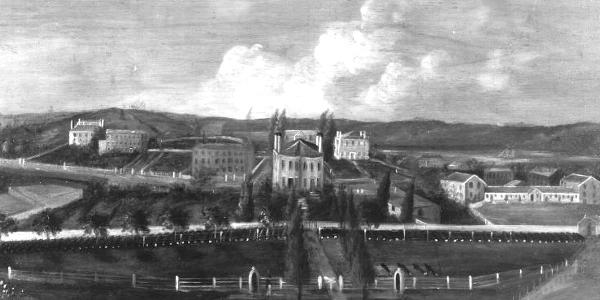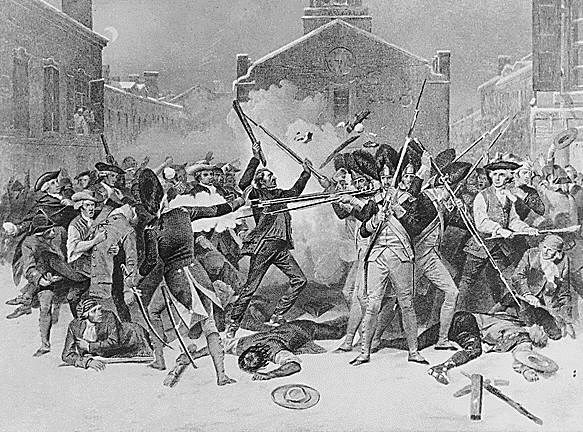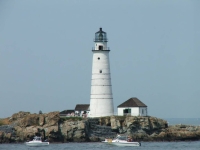
Above image: Paul Revere on his ride to warn the patriots that the British were coming. Right: The Boston Tea Party. Image source: Library of Congress.

Boston
From Old North Church and the ride of Paul Revere to the Boston Tea Party. From Crispus Attucks and the history of African Americans to form a nation, plus the struggles along the way. The city where the seeds of independence would be sown across the colonies down to Philadelphia and its hall. There's a famous hall here as well, Faneuil Hall, the site of the Committee of Correspondence. And there are famous men, sites, and vibrant history at almost every turn.
Sponsor this page. Your banner or text ad can fill the space above.
Click here to Sponsor the page and how to reserve your ad.

Boston Then
Massachusetts was a thriving colony prior to March 5, 1770. It was an envy of colonial patriots as well as the British, who were using the goods of the colony to allow their manufactures and economy to prosper. So when the Boston Massacre singed that partnership, that had been growing a weary tail for the past decade or more, it was a battle with a larger signal than its actual outcome. It was a signal for what would come five years later when a full blown war for independence was begun in greater measure. Yes, the Boston Massacre is considered the first battle of the Revolutionary War. The conflict was started at a customs commision where forty to fifty patriots were demonstrating. British troops engaged, firing into the crowd, killing five, including Mr. Attucks, a fugitive black slave and seaman.
For the next three years, a contentious relationship over trade policy and taxes waged back and forth across the Atlantic. On December 16, 1773, those acts reared another head. England had begun to allow the English East India Company to ship surplus tea to the colonies at a very low cost, thus causing a monopoly in the tea trade, and taxing the lot to boot. The colonists were steamed at the taxation without their consent and met at the Old South Meeting House to discuss a plan of action. That action became the Boston Tea Party, when three hundred and forty-two chests of tea were thrown overboard into the harbor.
British authorities continued to press hard on the colony of Massachusetts over the next two years, revoking self-rule, and provoking the colony, as well as the remainder of the colonies, to consider their options. By February of 1775, the British had declared Massachusetts to be in revolt; by April, lanterns were being hung in Old North Church and a colonist by the name of Paul Revere was riding furiously through the night to warn his friends, "The British are Coming. The British are Coming." And they were coming for war, first at Lexington, Concord, leading to Valley Forge, and Sarasota, to the battles of New Jersey, and eventually to Yorktown and true independence.
Boston Dates of Importance
March 5, 1770 - The Boston Massacre occurs when British troops fire into a Boston mob, which patriots used as an incident to further the colonists cause of rebellion.
April 12, 1770 - The Townshend Acts duties were repealed by British Parliament, except for the tax on tea.
November 2, 1772 - Samuel Adams organizes the Committee of Correspondence, a forerunner of the union of American colonies, that begins the American Revolution. The meeting was held in Faneuil Hall, Boston, and later repeated throughout the American colonies.
December 16, 1773 - The Boston Tea Party.
June 2, 1774. The Intolerable Acts were passed, requiring colonists to allow British soldiers into their homes, and also curtailed Massachusetts self-rule.
February 9, 1775 - The British government declares Massachusetts in rebellion.
April 18, 1775 - The midnight ride of Paul Revere and William Dawes warned their colleagues that the British were on the way. One day later, the Battles of Lexington and Concord saw the first major fighting of the Revolutionary War.
Photo above: Image above: Engraving of the Commandant's House, Boston National Historic Park, 1820. Commandant's House was built in 1805 in the Charlestown Navy Yard in Boston Harbor. Courtesy National Park Service. Photo below: Boston at twilight from the harbor and Boston Harbor Island National Recreation Area. Courtesy National Park Service.

Boston Now
Boston National Historic Park - This park explains the story of the American Revolution, including how it started, as well as the Navy's role in its victory. Start this tour on the Freedom Trail, either on your own or with a guide. There are also tours of other sites on the trail, including the USS Cassin Young, and the USS Constitution.
Boston African American National Historic Site - Located on Beacon Hill, this park is comprised of two dozen sites that comprise the largest area of pre-Civil War black-owned buildings where the fight to abolish slavery had many of its roots. There are fourteen sites along the Black Heritage Trail, including the Robert Gould Shaw Memorial, the African Meeting House, and the Museum of African-American History.
Minute Man National Historic Park - Not in Boston itself, but twenty-two miles away. However, no visit to Boston on an American Revolution history vacation would be complete without a visit to the Lexington and Concord battlefield sites located there.
Boston Harbor Island National Recreation Area - Over one thousand acres on thirty-four islands within a ferry ride of downtown Boston. Ferries depart from five Boston locations; Long Wharf, EDIC Pier, Pemberton Point, Ingham Shipyard, and Fore River Shipyard.
T-Shirts and Souvenirs

Boston History T-Shirts and other history souvenirs from the official merchandise of America's Best History.

Boston
Things You Should Not Miss
1. Walk down the three mile Freedom Trail on a 90 minute Park Ranger Tour at Boston National Historic Park. Along this route, you'll visit many of the famous sites from the history of Boston that you're familiar with from the history books, including the Bunker Hill Monument, Paul Revere's House, Faneuil Hall, Old North Church and Old South Meetings House, and the oldest commissioned warship in the world, the USS Constitution. You can do this tour on your own, but the park ranger guided walks are always a good way to get interpretation of the historic sites from an expert on the topic. These tours, however, are limited to thirty people per, and fill up quickly in the summer. They are filled on a first come, first serve, basis, first tour in summer at 10 a.m.
2. For a change of historic pace, visit the Boston National Recreation Area. It is a Ferry Ride and visit to the natural history, as well as nautical history of the area, and gets you out of the city for awhile and onto the water.
3. Visit Boston African American National Historic Site and learn more about the subsequent revolution and history of the African American struggle in Boston and throughout the nation. Fourteen historic structures in the Beacon Hill area of the city are there for your self-guided or ranger tour (in season). You can visit a few most days year round.
Photo above: Robert Gould Shaw monument to African American soldiers in the Civil War. Part of the Boston African American NHS History Trail. Courtesy National Park Service.

Get Baseball History and Books at Stat Geek Baseball, including Baseball's Best @ 150, counting down over 8,000 rankings of the best batters, pitchers, and fielders over the first 150 years (1871-2020) of Major League Baseball.



